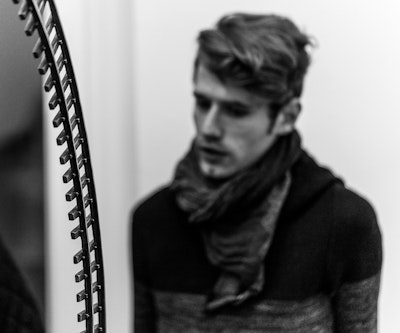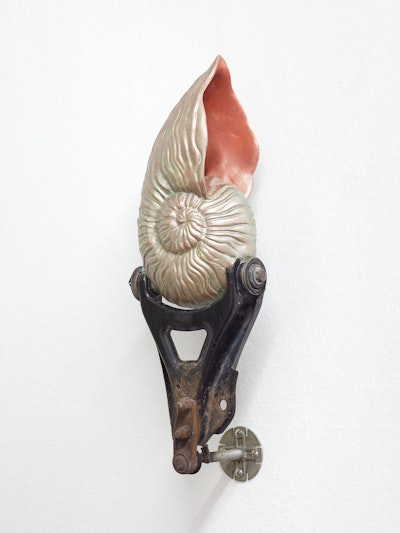Conversation in tandem with Marietta Clages (Clages, Cologne) and artist Christian Theiß, led by Emanuela Mazzonis
Emanuela Mazzonis: Good morning, Marietta Clages and Christian Theiß. Thank you for being with us today and for participating to in this cycle of interviews held by the Luxembourg Art Week and dedicated to a selection of galleries that are participating to in the fair for the first time. I'm Emanuela Mazzonis, editor of this project. First of all, I would like to ask Marietta to introduce her gallery based in Cologne and founded in 2008. The gallery's programme includes international artists of different artistic approaches from painting, sculpture and new media. And the gallery has participated already to many international art fairs. So I will let you introduce yourself, Marietta, and thank you again.
Marietta Clages: Yes, thank you for the invitation. For the Luxembourg Art Week, we present a concept emerging from the tension of contrasting textures and surfaces, and we will show… the gallery will introduce three new positions of the gallery, Christian Theiß on my side, and Isabella Fürnkäs and Bradley Davies. Isabella Fürnkäs is based in Berlin and Düsseldorf, and Bradley Davies is an English artist who studied with Michael Krebber in the Städelschule in Frankfurt and is based in Cologne. And Christian Theiß studied in Düsseldorf, with Rosemarie Trockel. And I think there might be no material Christian Theiß has not used to express his ideas of merging old shapes into new ones. The presented artworks employ ceramics, found objects, polymer and electrics, and hence mixing shiny industrial-looking materials into the pool of different textures. So the focus is on these three young artists, and for Luxembourg Art Week, we thought that it could be… open for us a new field for contemporary curators, like Michelle Cotton, she's working for the Mudam, and the Casino Luxembourg, where another artist from us, Shila Khatami, used to present her works. And so we thought that Luxembourg could be a very interesting place to present our positions.
EM: Fantastic. We will be very happy to see your stand at the fair. So thank you, Marietta. And now I would like to start with my first question to Christian. So in the press release of your exhibition at Clages, held in September 2020, Haris Giannouras opens his text by talking about prostheses to explain your work, in the sense of “procedure of completing and reassembling something together”. I find this definition very appropriate for your work process, and I wanted then to deepen a little bit more this topic. And I started reading the meaning of “prosthesis” in a dictionary and I found this following definition as the most common one: “Prosthesis is a device designed to replace a missing part of the body or to make a part of the body work better.” I would like now to dwell a little bit more on the word “device”, now used constantly to define technological devices that are filling our lives: smartphones, watches, tablets and so on. In our society dominated by all sorts of devices, I ask you, Christian, to talk more about the role you give to your artistic process that is so hand-crafted, in the sense of “artefact”, objects built manually merging old shapes into new ones from ceramics to found objects, polymer, electrics… Your objects are the result of an assembly of everyday objects to take on new compositions and new meanings. In art, that mentally bring[s] us back to the rediscovery of the more traditional artistic method, when the process of working the object and the dexterity of artistic gestures were an intrinsic element of the artistic work. Thank you, Christian.
Christian Theiß: That was a lot of information. Yes, it’s part of my work. It's a way to bring things in the world, of my thinking, so that other people can see and feel it. Of course, I use phones and screens and different technical devices, but they are not part of my work, so they never interest me artistically. In cultural studies, “prothesis” was coined by Marshall McLuhan. He said that technology would also express itself in analog areas. And for me it's… also in my work at Clages… I work with a lot of pictures of technical devices and I mix them with human bodies, animals… So new things can happen.
EM: Of course, another important element in your work is the relationship between memory and time. So the memory of a time that has passed but still remains part of our existence. The importance of time that flows towards an uncertain future. These are all themes that we find in your works. Your titles are very evocative. I'm thinking about… I'm saying the title in English… Swan Lake, The Item and its Shadow, Moment, Leaving in Circles. On the one hand, they refer us to topics from our past, but on the other hand, they guide us also toward questions about the future. So I would like to ask you, Christian, as an artist, and Marietta as a gallerist, how do you see the role of art unravelling in a world where the memory of the past and the passing of time seem to be overwhelmed by our frantic lives in the present? So my question is how important is the past to imagine and build our future? Christian, do you want to start first?
CT: I think it was very important for me in my artistical process, as a way to work, to learn from mistakes. Don't make them again in new works. So I think the structure of time is very important. So also, my process takes a lot of time. I have to step back, I have to wait to find the right thing, the right solution. Sometimes I'm working for years on one work and many things happen directly in the same way.
MC: Yes, I think when you look at Christian Theiß’s work and the way he puts together art-historical pieces and puts it onto a new level, it explores a new world. And this fantasy world, what he has to present… to offer the artworld is very relevant. And I think it's always good to see as an observer of art, to be… to feel the wonder what art can do with someone.
CT: That’s the thing I want to do. I want to touch some human feeling. So it's not about that machine only. So it's not about a time context – I'm trying to make artworks that can be seen from different times, from different contexts. It's not about now. It's also seen from the future, from the past.
EM: And I think also the fact that you are using different materials and parts of objects that are also part of our daily life, we can actually recognise, we can pick the meaning of that object, but that has been recontextualised in your proper works, in a new life, in a new… also passage of life and time, I believe.
MC: And it always reflects also the craziness of this world. So nothing is sure, nothing is secure and everything is very fragile. And this fragility is also represented in this work.
EM: I think it's very important to… as a viewer to mix together all the different level[s] of time in order to put also yourself in relation, of course, to your work. And also, I believe what is very important in your work is the space, the space that surrounds the artwork.
MC: If can say this, when Christian puts an artwork together or develops an artwork, he really concentrates on the whole world. It’s the nature, it's the animals and it's the normal technical material which surrounds our daily life. And he really is able to make this visible and to show in what kind of world we are living. But without this strategic implementation of, you know, “you don't have to do this or that”. He's not criticising.
EM: No judgement, yes.
MC: Yeah, no judgement. Exactly.
EM: Yes, absolutely. That is definitely true. So can you anticipate us what will be shown at the fair? No, it's going to be a surprise I believe…
MC: Yes. Of course, we we won't say too much, but there will be a huge display that Christian will develop. But, of course, we will show paintings from Bradley Davis, drawings from Isabella Fürnkäs. And on this display that Christian will develop there will be shown ceramics, which you can see here. It will go in this kind of direction. But we are working on that right now.
EM: Fantastic.

